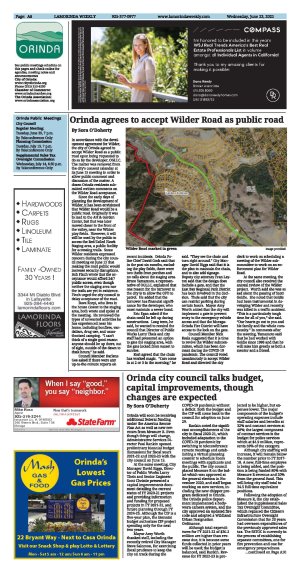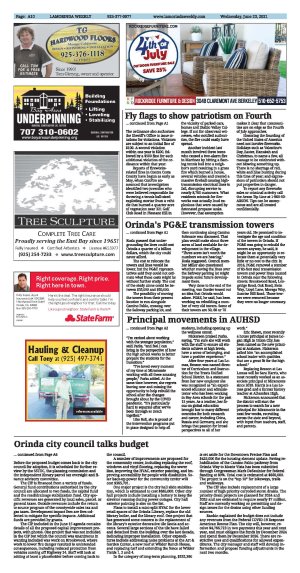|
|
Published June 23rd, 2021
|
Orinda city council talks budget, capital improvements, though changes are expected
|
|
| By Sora O'Doherty |
| |
|
Orinda will soon be receiving additional federal funding under the America Rescue Plan Act as well as new revenues from Measure R. Even though things will change, Administrative Services Director Paul Rankin opened preliminary biennial budget discussions for fiscal years 2021-22 and 2022-23 with the city council on June 15.
 At the same meeting, City Manager David Biggs, Director of Public Works Larry Theis and Senior Engineer Scott Christie presented a capital improvements document detailing the current status of FY 2020-21 projects and providing information and funding for proposed projects in FY 2021-22, and future planning through FY 2024-25. Although the CIP is a five-year plan, the biennial budget authorizes CIP project spending only for the next two years.
At the same meeting, City Manager David Biggs, Director of Public Works Larry Theis and Senior Engineer Scott Christie presented a capital improvements document detailing the current status of FY 2020-21 projects and providing information and funding for proposed projects in FY 2021-22, and future planning through FY 2024-25. Although the CIP is a five-year plan, the biennial budget authorizes CIP project spending only for the next two years.
 Mayor Amy Worth thanked staff, including the recently retired City Manager Steve Salomon, for exercising fiscal prudence to keep the city on track during the COVID-19 pandemic without a deficit. Both the budget and the CIP will come back to the council for adoption on June 29.
Mayor Amy Worth thanked staff, including the recently retired City Manager Steve Salomon, for exercising fiscal prudence to keep the city on track during the COVID-19 pandemic without a deficit. Both the budget and the CIP will come back to the council for adoption on June 29.
 Rankin noted the significant accomplishments of the city in fiscal 2020-21, which included adaptation to the COVID-19 pandemic by switching to teleconference remote meetings and establishing a virtual planning counter to schedule Zoom meetings with applicants and the public. The city council placed Measure R on the ballot which was approved at the general election in November 2020, and staff began working on new services, including the new chipper program dedicated to Orinda. The Orinda police department implemented a body-worn camera system, and the city approved an updated fire code and adopted a Wildland Urban Designation Ordinance.
Rankin noted the significant accomplishments of the city in fiscal 2020-21, which included adaptation to the COVID-19 pandemic by switching to teleconference remote meetings and establishing a virtual planning counter to schedule Zoom meetings with applicants and the public. The city council placed Measure R on the ballot which was approved at the general election in November 2020, and staff began working on new services, including the new chipper program dedicated to Orinda. The Orinda police department implemented a body-worn camera system, and the city approved an updated fire code and adopted a Wildland Urban Designation Ordinance.
 Although total expenditures for FY 2021-22 of $30.2 million are higher than revenue due, it is because some funds collected in prior years will be used; the budget is balanced, said Rankin. Revenue for FY 2022-23 is projected to be higher, but expenses lower. The major components of the budget's operating expenses include staff salaries and benefits at 32% and contract services at 48%; the largest component of contract services is the budget for police services which at $4.9 million, represents 59% of the category.
Although total expenditures for FY 2021-22 of $30.2 million are higher than revenue due, it is because some funds collected in prior years will be used; the budget is balanced, said Rankin. Revenue for FY 2022-23 is projected to be higher, but expenses lower. The major components of the budget's operating expenses include staff salaries and benefits at 32% and contract services at 48%; the largest component of contract services is the budget for police services which at $4.9 million, represents 59% of the category.
 Although city staffing will increase, it will remain below the number prior to FY 2017-18. A new, full-time employee is being added, and the position is being funded 80% with Measure R revenue and 20% from the general fund. This will bring city staff total to 34.5 full-time equivalent positions.
Although city staffing will increase, it will remain below the number prior to FY 2017-18. A new, full-time employee is being added, and the position is being funded 80% with Measure R revenue and 20% from the general fund. This will bring city staff total to 34.5 full-time equivalent positions.
 Following the adoption of Measure R, the city established the Supplemental Sales Tax Oversight Committee, which replaced the Citizen's Infrastructure Oversight Commission that for 20 years had overseen expenditures of the previously approved sales tax. The SSTOC is currently in the process of establishing separate committees, one for fire prevention and one for emergency preparedness. Before the proposed budget comes back to the city council for adoption, it is scheduled for further review by the SSTOC, the planning commission and the independent library parcel tax oversight and finance advisory committee.
Following the adoption of Measure R, the city established the Supplemental Sales Tax Oversight Committee, which replaced the Citizen's Infrastructure Oversight Commission that for 20 years had overseen expenditures of the previously approved sales tax. The SSTOC is currently in the process of establishing separate committees, one for fire prevention and one for emergency preparedness. Before the proposed budget comes back to the city council for adoption, it is scheduled for further review by the SSTOC, the planning commission and the independent library parcel tax oversight and finance advisory committee.
 The CIP is financed from a variety of funds. General fund contributions authorized by the city council are allocated to two funds, the capital fund and the road/drainage stabilization fund. City specific revenues are generated by local sales, parcel. or general taxes. Outside revenues include the return to source program of the countywide sales tax and gas taxes. Development impact fees are fees collected to mitigate for specific impacts. Additional funds are provided by grants.
The CIP is financed from a variety of funds. General fund contributions authorized by the city council are allocated to two funds, the capital fund and the road/drainage stabilization fund. City specific revenues are generated by local sales, parcel. or general taxes. Outside revenues include the return to source program of the countywide sales tax and gas taxes. Development impact fees are fees collected to mitigate for specific impacts. Additional funds are provided by grants.
 The CIP included in the June 15 agenda contains details of all the proposed capital improvement projects, with photos. One project that was not included in the CIP but which the council was unanimous in wanting included was work on Brookwood, where work to lower fire danger resulted in unintended consequences, including reduced protection from vehicles coming off Highway 24. Staff will look at adding at least a placeholder before coming back to the council.
The CIP included in the June 15 agenda contains details of all the proposed capital improvement projects, with photos. One project that was not included in the CIP but which the council was unanimous in wanting included was work on Brookwood, where work to lower fire danger resulted in unintended consequences, including reduced protection from vehicles coming off Highway 24. Staff will look at adding at least a placeholder before coming back to the council.
 A number of improvements are proposed for the community center, including replacing the roof, windows and vinyl flooring, replacing the sewer line, improving the HVAC, exterior painting, and improving accessibility for people with disabilities. Solar back-up power for the community center will cost $365,701.
A number of improvements are proposed for the community center, including replacing the roof, windows and vinyl flooring, replacing the sewer line, improving the HVAC, exterior painting, and improving accessibility for people with disabilities. Solar back-up power for the community center will cost $365,701.
 One major project is the city hall slide stabilization, which is estimated to cost $885,000. Other city hall projects include installing a battery to keep the elevator running during power outages. City hall exterior painting is also on the list.
One major project is the city hall slide stabilization, which is estimated to cost $885,000. Other city hall projects include installing a battery to keep the elevator running during power outages. City hall exterior painting is also on the list.
 Plans to install a mini-split HVAC for the lower retail spaces of the Orinda Library, replace the old library boiler, and the library roof. One project that has generated some concern is the replacement of the library's exterior decorative tile fascia and accents. Several large sections of the tile have failed and detached from the building over the last decade, indicating improper installation. Other expenditures include addressing noise problems at the Art & Garden Center, a new roof at Wilder Ranch House, and replacing turf and extending the fence at Wilder Fields 1, 2 and 4.
Plans to install a mini-split HVAC for the lower retail spaces of the Orinda Library, replace the old library boiler, and the library roof. One project that has generated some concern is the replacement of the library's exterior decorative tile fascia and accents. Several large sections of the tile have failed and detached from the building over the last decade, indicating improper installation. Other expenditures include addressing noise problems at the Art & Garden Center, a new roof at Wilder Ranch House, and replacing turf and extending the fence at Wilder Fields 1, 2 and 4.
 In the category of long-term planning, $532,360 is set aside for the Downtown Precise Plan and $425,000 for the housing element update. Paving rehabilitation of the Camino Pablo pathway from Orinda Way to Monte Vista has been submitted through Congressman Mark DeSaulnier for federal funding at 80%. Total cost is estimated at $660,000. The project is on the "top 10" for bikeways, trails and walkways.
In the category of long-term planning, $532,360 is set aside for the Downtown Precise Plan and $425,000 for the housing element update. Paving rehabilitation of the Camino Pablo pathway from Orinda Way to Monte Vista has been submitted through Congressman Mark DeSaulnier for federal funding at 80%. Total cost is estimated at $660,000. The project is on the "top 10" for bikeways, trails and walkways.
 The CIP also include replacement of a large number of high priority corroded storm drains. The priority drain projects are planned for 2024 and 2025 and are estimated to require nearly $7 million. Staff are currently working on permitting and design issues for the drains using other funding sources.
The CIP also include replacement of a large number of high priority corroded storm drains. The priority drain projects are planned for 2024 and 2025 and are estimated to require nearly $7 million. Staff are currently working on permitting and design issues for the drains using other funding sources.
 Rankin explained the budget does not include any revenues from the Federal COVID-19 Response American Rescue Plan. The city will, however, receive $4,766,723 in two payments this year and next year, and must obligate the funds by December 2024 and spend them by December 2026. There are restrictive uses and qualifications for allowed expenditures. The city manager and staff will develop information and propose funding adjustments in the next two months.
Rankin explained the budget does not include any revenues from the Federal COVID-19 Response American Rescue Plan. The city will, however, receive $4,766,723 in two payments this year and next year, and must obligate the funds by December 2024 and spend them by December 2026. There are restrictive uses and qualifications for allowed expenditures. The city manager and staff will develop information and propose funding adjustments in the next two months. |
|
|



